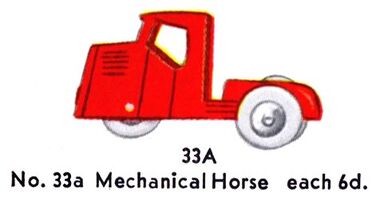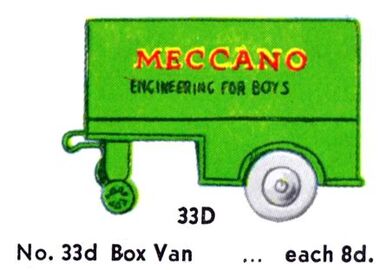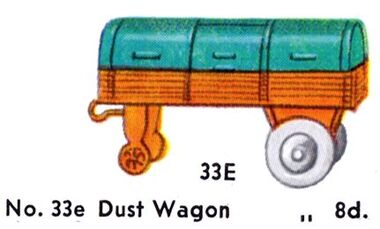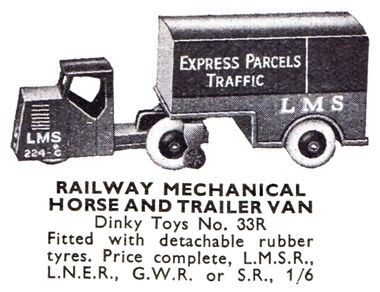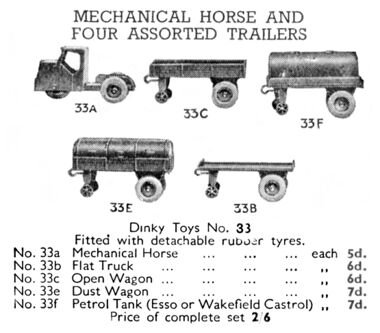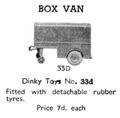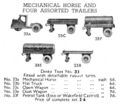Category:Mechanical Horse
1935: Dinky 33a Mechanical Horse [image info]
1935: Dinky 33d, one of a range of "Mechanical Horse" trailers [image info]
1935: Dinky 33e Dust Wagon for Mechanical Horse [image info]
1936: Dinky Toys 33R Mechanical Horse and Trailer combinations available with markings for all the major railway companies [image info]
1939: Dinky Mechanical Horse range [image info]
The three-wheeler Mechanical Horse was initially designed by Napier for the LNER railway. Scammell bought the design and prototype, and after further development by Oliver Danson North in 1933, the vehicle was launched in 1934 and became one of the company's most popular lines.
The vehicle's arrival in the early-to-mid 1930s, it's visibility at railway stations and its range of possible accessories and consequential play value, made it an obvious choice for inclusion in the Dinky Toys range in 1935.
The Scammell Scarab
Nowadays, the concept is more strongly associated with Scammell's later development of the three-wheeler, reverse autocoupling idea, the less archaically-named Scammell Scarab, whose branding suggested the vehicle's ability to "beetle about".

The 1930s Tri-ang Minic range of clockwork toys included some truck-and-trailer vehicles with four-wheeler cabs referred to in Tri-ang's literature as "Mechanical Horses" – we're not currently sure whether these represent other Scammell vehicles, or whether the name was being used generally for trucks with detachable trailers. If "Mechanical Horse" was being used as a generic term, this might explain Scammell's desire with the "Scarab" to introduce a more more specific name that they could promote without it then being used by their competitors.
Concept
The problem facing the LNER and other railway companies in the 1930s was that their parcels and luggage-handling systems had been designed around the use of horses, and hadn't been developed with the idea that horses might be eventually replaced by motorised vehicles.
This meant that anything that replaced the horse had to be designed to be able to cope with tricky situations that normal road vehicles couldn't manage – a "Mechanical Horse" had to be efficient, not too noisy to be driven across a station platform, it had to have high visibility, be capable to driving very slowly and carefully, and it had to be incredibly manoeuvrable in order to be able to work within narrow spaces that horses could cope with – the cab road at Southern Railway's Brighton Station, for example, had a tight 180-degree bend that was covered-over to create a tunnel that normal vehicles couldn't manage, and which could not be expanded.
As well as an incredibly tight turning-circle, the Mechanical Horse had to be able to emulate the behaviour of real horses in being able to back up into a wagon and pull it away ... the difference being that with a real horse, the handler would be in charge of the coupling, whereas with the motorised version, the driver would have to be able to stay in the cab – the motorised horse and its wagons needed a special coupling that allowed the driver to back up into a wagon or container and have it couple automatically, then drive off.
The Mechanical Horse wagons typically had a full set of back wheels and a smaller pair of support wheels and the front - backing into the wagon would result in the sloped coupling pushing itself under the wagon and lifting the small support wheels up off the ground, after which the wagon would be supported at the front by the cab coupling.
Use
The Mechanical Horse has obviously popular in railway stations, but also found niche applications in other situations where manoeuvrability in confined spaces was important, so it was used in warehouses, onboard some larger ships, and in some cases as a delivery vehicle in situations where speed wasn't a primary need.
External links
Pages in category ‘Mechanical Horse’
This category contains only the following page.
Media in category ‘Mechanical Horse’
The following 35 files are in this category, out of 35 total.
- Box Van, Dinky Toys 33d (1935 BoHTMP).jpg 438 × 311; 24 KB
- Box Van, Dinky Toys 33d (MCat 1939).jpg 856 × 841; 65 KB
- BR Articulated Van, canvas top, Budgie Toys 240 (Budgie 1961).jpg 1,370 × 869; 248 KB
- BR Articulated Van, hard top, Budgie Toys 238 (Budgie 1961).jpg 1,373 × 1,033; 260 KB
- Dust Wagon, Dinky Toys 33e (1935 BoHTMP).jpg 431 × 260; 21 KB
- Flat Truck, Dinky Toys 33b (1935 BoHTMP).jpg 484 × 198; 14 KB
- Mechanical Horse and Cable Trailer with Drums, Triang Minic (MinicCat 1950).jpg 1,557 × 757; 168 KB
- Mechanical Horse and Four Assorted Trailers, Dinky Toys 33 (MCat 1939).jpg 1,479 × 1,297; 205 KB
- Mechanical Horse and Four Trailers, box lid (Dinky Toys 33).jpg 3,000 × 1,903; 1.44 MB
- Mechanical Horse and Fuel Oil Trailer, Shell BP, Minic 2847 (TriangCat 1937).jpg 1,372 × 830; 232 KB
- Mechanical Horse and Log Trailer, Triang Minic (MinicCat 1950).jpg 1,475 × 694; 167 KB
- Mechanical Horse and Lorry with Cases, Triang Minic (MinicCat 1950).jpg 1,310 × 782; 151 KB
- Mechanical Horse and Milk Tanker, Minic 70M.jpg 339 × 192; 12 KB
- Mechanical Horse and Milk Tanker, Triang Minic (MinicCat 1950).jpg 1,374 × 748; 160 KB
- Mechanical Horse and Open Wagon, Dinky Toys 415 (DinkyCat 1956-06).jpg 1,331 × 910; 238 KB
- Mechanical Horse and Pantechnicon, Minic 2846 (TriangCat 1937).jpg 1,424 × 861; 257 KB
- Mechanical Horse and Pantechnicon, Triang Minic (MinicCat 1937).jpg 1,040 × 740; 163 KB
- Mechanical Horse and Pantechnicon, Triang Minic (MinicCat 1950).jpg 1,383 × 791; 172 KB
- Mechanical Horse and Petrol Tanker, Triang Minic (MinicCat 1950).jpg 1,389 × 801; 167 KB
- Mechanical Horse and Trailer with 6in Cruiser, Triang Minic (MinicCat 1950).jpg 1,573 × 715; 174 KB
- Mechanical Horse and Trailer with cases, Minic 2856 (TriangCat 1937).jpg 1,375 × 699; 198 KB
- Mechanical Horse and Trailer with Cases, Minic 40M, 1939.jpg 706 × 425; 46 KB
- Mechanical Horse and Trailer with Cases, Triang Minic (MinicCat 1937).jpg 1,040 × 740; 163 KB
- Mechanical Horse, Dinky Toys 33a (1935 BoHTMP).jpg 476 × 247; 16 KB
- Mechanical Horse, Dinky Toys 415 (DinkyCat 1957-08).jpg 2,845 × 1,409; 481 KB
- Mechanical Horse, Matchbox No10 (MBCat 1959).jpg 1,925 × 818; 553 KB
- Open Wagon, Dinky Toys 33c (1935 BoHTMP).jpg 476 × 221; 15 KB
- Petrol Tank, Dinky Toys 33f (1935 BoHTMP).jpg 441 × 275; 17 KB
- Railway Mechanical Horse and Trailer Van, Dinky Toys 33r (MCat 1939).jpg 1,476 × 949; 172 KB
- Railway Mechanical Horse and Trailer Van, Dinky Toys 33R (MM 1936-06).jpg 1,131 × 869; 144 KB
- Scammell Scarab, box art, side, cable drum (Crescent Toys).jpg 1,800 × 424; 163 KB
- Scammell Scarab, box art, side, open truck (Crescent Toys).jpg 1,800 × 427; 166 KB
- Scammell Scarab, box art, top (Crescent Toys).jpg 1,800 × 553; 224 KB
